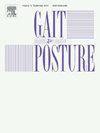Effects of arch support on gait and postural control in middle-aged and older adults
IF 2.2
3区 医学
Q3 NEUROSCIENCES
引用次数: 0
Abstract
Objective
In this study, we examined the effects of arch support on middle-aged and older adults’ gait and postural control.
Methods
Forty-five middle-aged and older adults completed four study visits. On the first visit, the physical characteristics of each participant were determined. On each of the other three visits, participants completed the protocol under three different conditions: arch supportive footwear (SF), non-supportive footwear (NF), and barefoot (BF). Then participants first performed the single-leg stance test (SLST) and standing postural sway test (SPST). This was followed by a walking assessment (WA), with walking data recorded using wireless sensors. Finally, participants completed a 5-minute energy cost of walking test (CWT) on a treadmill.
Results
It was observed that compared to BF, SF had significantly longer time on SLST in CF condition (p = 0.036). However, for COP area in EC condition and mean velocity of COP in EO or EC condition, SF participants had significantly increased compared to BF (p < 0.046). In addition, SF had significantly higher energy cost of walking compared to BF (p < 0.033).
Conclusion
This study demonstrated that arch support can help single leg standing balance and improve walking performance by increasing stride length.
足弓支撑对中老年人步态和姿势控制的影响
目的探讨足弓支撑对中老年人步态和姿势控制的影响。方法45名中老年受试者完成4次研究访视。在第一次访问时,确定了每个参与者的身体特征。在其他三次访问中,参与者在三种不同的条件下完成了协议:足弓支撑鞋(SF),非支撑鞋(NF)和赤脚(BF)。受试者首先进行单腿站立测试(SLST)和站立姿势摇摆测试(SPST)。随后进行步行评估(WA),使用无线传感器记录步行数据。最后,参与者在跑步机上完成5分钟步行能量消耗测试(CWT)。结果CF条件下SF在SLST上的时间明显长于BF (p = 0.036)。而在EC状态下的COP面积和EO或EC状态下的COP平均速度方面,SF参与者比BF显著增加(p <; 0.046)。此外,SF的行走能量成本显著高于BF (p <; 0.033)。结论足弓支撑可以通过增加步幅来提高单腿站立平衡和步行能力。
本文章由计算机程序翻译,如有差异,请以英文原文为准。
求助全文
约1分钟内获得全文
求助全文
来源期刊

Gait & posture
医学-神经科学
CiteScore
4.70
自引率
12.50%
发文量
616
审稿时长
6 months
期刊介绍:
Gait & Posture is a vehicle for the publication of up-to-date basic and clinical research on all aspects of locomotion and balance.
The topics covered include: Techniques for the measurement of gait and posture, and the standardization of results presentation; Studies of normal and pathological gait; Treatment of gait and postural abnormalities; Biomechanical and theoretical approaches to gait and posture; Mathematical models of joint and muscle mechanics; Neurological and musculoskeletal function in gait and posture; The evolution of upright posture and bipedal locomotion; Adaptations of carrying loads, walking on uneven surfaces, climbing stairs etc; spinal biomechanics only if they are directly related to gait and/or posture and are of general interest to our readers; The effect of aging and development on gait and posture; Psychological and cultural aspects of gait; Patient education.
 求助内容:
求助内容: 应助结果提醒方式:
应助结果提醒方式:


